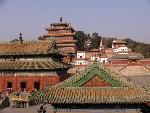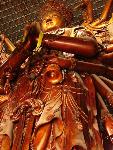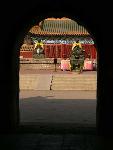- Getting around Lijiang. Dont stay in the Old Towns more than 2 days, there is nothing to do. KRISS Oct 9, 2013 05:46
- 2013 Beijing Temple Fair BENNYLAU Feb 26, 2013 03:29
- Malaysian traveling from KUL - LAX vis Shanghai PVG ZATI_DY Jan 3, 2013 20:15
An Emperors' Playground - Part Two
- Views: 4076
- |Vote: 0 0
- |Add to Favorites
- |Recommend to Friends
The Outlying Temples
Visitors to the historical city of Chengde are often surprised by what they find. The Emperors who saw a great Summer Palace built here apparently weren’t about to do things by halves – and constructed an Imperial work and leisure complex the size of a small town. During my visit to the Mountain Resort, I had wandered right throughout the palace facilities and seen marvellous great halls for matters of state as well as places for rest and meditation. Even so, I knew that much of what was once here is now gone, lost to ruins a hundred years ago, and that some were deliberately removed – I saw the remaining fragmants of a temple built entirely out of iron, destroyed by the invading Japanese in the Second World War to be smelted down for weapons manufacture – perhaps the ultimate desecration of a sacred building.
Despite the marvels of the Mountain Resort, many find the most compelling remnants of this ostentatious project outside its walls – where the Emperors, in the act of trying to please everybody, had overseen the construction of at least twelve great temples designed to accommodate the faiths and sects of anyone from within the empire who might need to come and call on the Emperor. The Chengde Outlying Temples are each and every one unique to the series, but manifest a variety of architectural factors from all around the country. Although all the temples are within walking distance of the resort, visiting any one temple could take half the day, and so a comprehensive survery of what remains of them in these times would take half a week. Most have time only for a few of them, and I resolved to get to see as many as possible in the time I had available to me. Taxis and busses make the job easier for many short on time, But I had decided to test my resolve and endurance by staying on my feet as much as possible and thus getting to know the surrounding city suburbs as well – besides, when you’re on a budget, it’s always best to make the most of your own legs.
Busses that pass the front gate of the Mountain Resort park compound go out in every direction towards the temples, and I only needed to choose which I wanted to see first. I also had the frustrating problem of contradictory information – my guide book was a little out of date, as several of the outlying temples have been recently restored, and even the brand new tourist map seemed to show some historical temples as still being around today, even though other information I’d checked seemed to indicate that they’d been destroyed long ago. The safest bet was to head directly for the most popular and famous temple of the series – the Puning Temple – and begin from there.
It being the middle of Winter, the town was fairly quiet and by the time I’d been let off near the entrance gate of the Puning Temple, I’d arrived in the middle of a district that seemed empty of tourists. A few locals wandered around the lanes, and as I followed the signs I was pleasantly surprised to find that suburban Chengde is very traditional-looking, typical old-style small-town Hebei with lots of twisting little alleyways and low, stone homes billowing out the smells of coal fires and cooking. It seemed the perfect spot to explore old temples.
Walking in Prayerful Footsteps
I was enchanted by the sounds of bells as I entered the courtyard of the Puning Temple – and was a little taken aback to see real Tibetan Monks wandering around in a complex that I’d presumed to be the remains of what was once a great religious centre. In fact, the Puning temple is the only one of the old series to remain active – devotees here walk in the old footsteps of their Qing Dynasty forebears, chanting the old mantras as was done centuries before.
I was on the lookout for evidence of the most well-known feature of all the Chengde temples – cosmopolitanism in design. Whilst each temple has a prominent basic style that makes up the foundation of its layout, each one actually encompasses the features of many different temple forms. In the Puning Temple, the Tibetan style is at the forefront, but the common Han traditional structures were still represented, albeit transformed and imaginatively reworked to meld seamlessly with the other schools of design. Although the significance is difficult to see today, the Chengde Temples were really a revolution in temple art – back in the eighteenth century, they must have seemed like something out of science-fiction.
If you’ve been to Tibet, you may well have had the experience of wandering up mountain slopes in temple yard interiors, towers on either side of you dyed in austere scarlets and dusty whites, carried up by the smell of incense and the deep rumble of prayer. If you can’t get to Tibet easily, this is a close approximation – I found myself ascending reverently as I made my way to the rear prayer hall, which contains the most famous sight in Chengde – a 23-metre tall Guanyin Buddha made of wood, making it the largest wooden Buddha in the world.
As an admirer of the Buddhist religion, I am a particular fan of the Guanyin Buddha, a female manifestation who is otherwise known as the Goddess of Mercy. This statue of her is truly magnificent, and I spent a good ten minutes standing at the bottom admiringly. There’s a ticket available for climbing the upper stories to see her at eye level – but I declined out of respect for my budget that was already rather depressed by the fact that each temple I was going to visit carries an entrance fee of RMB20-50. A few suspiciously non-religious looking fellows were relaxing on chairs outside the temple claiming to be invested with the holy power to extend the blessing of the Guanyin Buddha for the mere cost of RMB100. I politely declined the invitation.
Worrying About Money
I'd certainly taken a fair blow to the wallet already, what with hotel expenses, Spring Festival peak-season travel costs, and the entrance tickets to the Mountain Resort and the Puning Temple. Walking around the monk's quarters behind the Guanyin Buddha's lofty tower, I resolved to be as frugal as possible for the remainder of my trip. I admired the quiet lives of the monks who lived here, whom I presumed didn't have to think about money – I spied a couple reading prayer books in the sunshine in the temple gardens and envied their sence of quiet inner balance.
I exited the temple to the side, finding myself right in the middle of a bizarre shopping complex that had been built into the former hutong dwellings of local citizens. It wasn't a good time for the merchants as temple visitors were few, and I was hollered at incessantly as I walked through the market. Everything to do with Buddhism was on sale – beads, incense, shining little Buddha statues in their wooden huts. Souvenirs and clothing were plentiful, and I had a very hard time convincing the sellers who approached me that in fact I didn't want to buy anything at all.
I was headed for another temple right next door to the Puning Temple – the Puyou Temple, which is far smaller in scale but also very well restored. My guidebook told me that the layout was predominantly Manchurian – and I was quite interested in having a look inside, were it not for the fact the the door price seemed an unfair RMB30.
I knew that there were far more important temples to be seen in Chengde, and so I made the difficult choice to skip over this one. It seemed a shame to turn away at the front door, however, and I hopped around the walls to see if I could at least catch a glimpse of what was inside. From one angle, I could see the front yard very clearly with what appeared to be a broad courtyard. A central white path led inwards, and along its sides were rows of olive-green Buddhist saints, poised as if they were in deep conversation about crucial matters of the spirit.
My map suggested that there was a third temple just a little further on from the Puyou Temple, and so I wandered along in the same direction to see if I could find it, because my other sources made no mention of it at all. There it was – now apparently a farmhouse – and I stood quite fascinated to see the sensuous arched roofs of the temple halls propped up with wooden beams, housing pigs and a pair of viscious guard dogs. They snarled at me menacingly and so I surveyed from a greater distance, wondering if this temple would ever be restored, and wondering what the conditions of the other temples must have been like before the local government gave the go-ahead to spruce them up for tourists.
According to my map, these were all of the temples in this quarter of the city, and so I set out on my first long walk of the day to see if I could find some of the others, seemingly only a short distance away.






 Copyright © 1998-2025 All rights reserved.
Copyright © 1998-2025 All rights reserved.